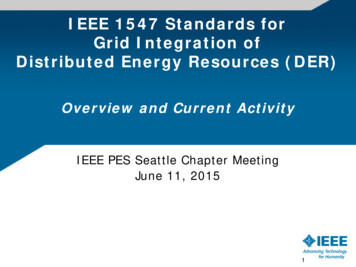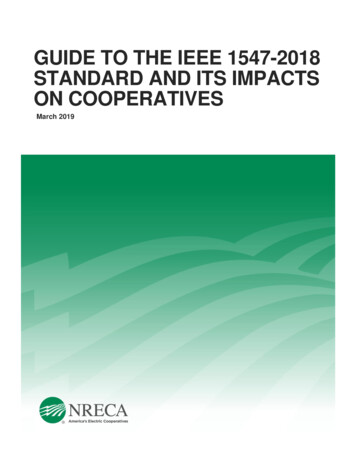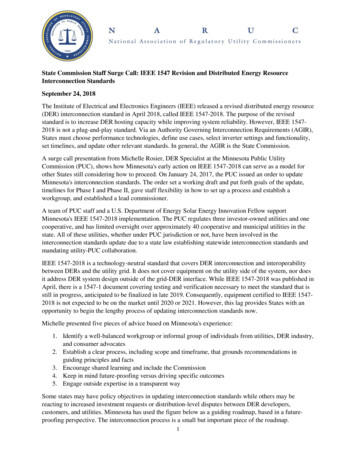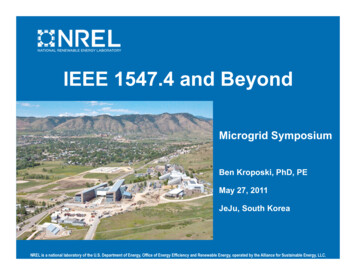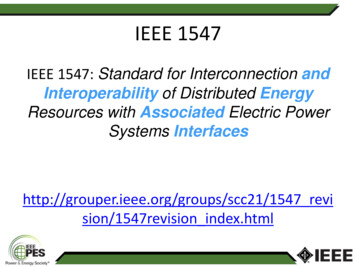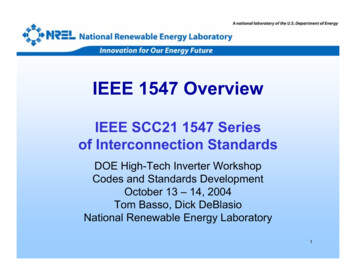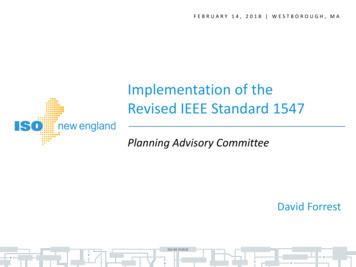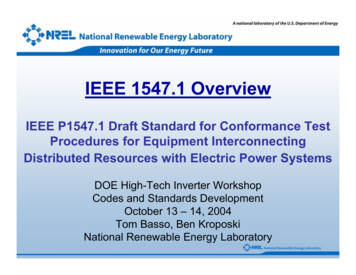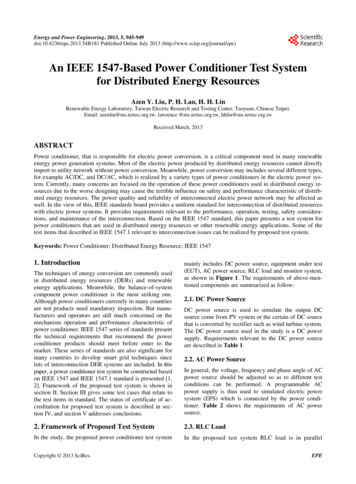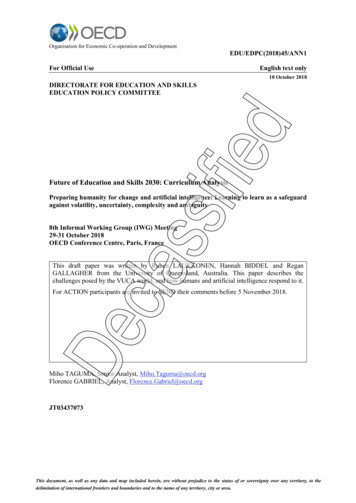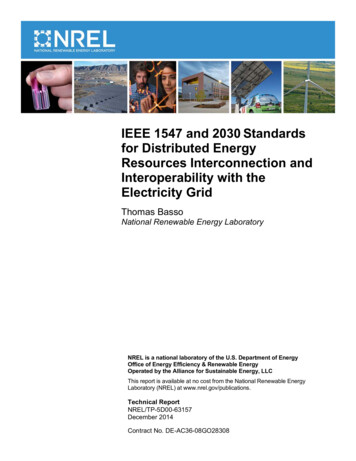
Transcription
IEEE 1547 and 2030 Standardsfor Distributed EnergyResources Interconnection andInteroperability with theElectricity GridThomas BassoNational Renewable Energy LaboratoryNREL is a national laboratory of the U.S. Department of EnergyOffice of Energy Efficiency & Renewable EnergyOperated by the Alliance for Sustainable Energy, LLCThis report is available at no cost from the National Renewable EnergyLaboratory (NREL) at www.nrel.gov/publications.Technical ReportNREL/TP-5D00-63157December 2014Contract No. DE-AC36-08GO28308
IEEE 1547 and 2030 Standardsfor Distributed EnergyResources Interconnectionand Interoperability with theElectricity GridThomas BassoNational Renewable Energy LaboratoryPrepared under Task Nos. SS13.0550 and DP12.2014NREL is a national laboratory of the U.S. Department of EnergyOffice of Energy Efficiency & Renewable EnergyOperated by the Alliance for Sustainable Energy, LLCThis report is available at no cost from the National Renewable EnergyLaboratory (NREL) at www.nrel.gov/publications.National Renewable Energy Laboratory15013 Denver West ParkwayGolden, CO 80401303-275-3000 www.nrel.govTechnical ReportNREL/TP-5D00-63157December 2014Contract No. DE-AC36-08GO28308
NOTICEThis report was prepared as an account of work sponsored by an agency of the United States government.Neither the United States government nor any agency thereof, nor any of their employees, makes any warranty,express or implied, or assumes any legal liability or responsibility for the accuracy, completeness, or usefulness ofany information, apparatus, product, or process disclosed, or represents that its use would not infringe privatelyowned rights. Reference herein to any specific commercial product, process, or service by trade name,trademark, manufacturer, or otherwise does not necessarily constitute or imply its endorsement, recommendation,or favoring by the United States government or any agency thereof. The views and opinions of authors expressedherein do not necessarily state or reflect those of the United States government or any agency thereof.This report is available at no cost from the National Renewable EnergyLaboratory (NREL) at www.nrel.gov/publications.Available electronically at http://www.osti.gov/scitechAvailable for a processing fee to U.S. Department of Energyand its contractors, in paper, from:U.S. Department of EnergyOffice of Scientific and Technical InformationP.O. Box 62Oak Ridge, TN 37831-0062phone: 865.576.8401fax: 865.576.5728email: mailto:reports@adonis.osti.govAvailable for sale to the public, in paper, from:U.S. Department of CommerceNational Technical Information Service5285 Port Royal RoadSpringfield, VA 22161phone: 800.553.6847fax: 703.605.6900email: orders@ntis.fedworld.govonline ordering: http://www.ntis.gov/help/ordermethods.aspxCover Photos: (left to right) photo by Pat Corkery, NREL 16416, photo from SunEdison, NREL 17423, photo by Pat Corkery, NREL16560, photo by Dennis Schroeder, NREL 17613, photo by Dean Armstrong, NREL 17436, photo by Pat Corkery, NREL 17721.NREL prints on paper that contains recycled content.
Acronyms and AbbreviationsAHJauthority having jurisdictionDERdistributed energy resourcesDOEU.S. Department of EnergyEPSelectric power systemEUTequipment under testIEEEInstitute of Electrical and Electronics EngineersNECNational Electrical CodeNRELNational Renewable Energy LaboratoryPUCpublic utility commissionSGIRMSmart Grid Interoperability Reference ModelULUnderwriters LaboratoriesiiiThis report is available at no cost from the National Renewable Energy Laboratory (NREL) at www.nrel.gov/publications.
Executive SummaryPublic-private partnerships have been a mainstay of the U.S. Department of Energy and theNational Renewable Energy Laboratory (DOE/NREL) approach to research and development.These partnerships also include technology development that enables grid modernization anddistributed energy resources (DER) advancement, especially renewable energy systemsintegration with the grid. Through DOE/NREL and industry support of Institute of Electrical andElectronics Engineers (IEEE) standards development, the IEEE 1547 series of standards hashelped shape the way utilities and other businesses have worked together to realize increasingamounts of DER interconnected with the distribution grid. And more recently, the IEEE 2030series of standards is helping to further realize greater implementation of communications andinformation technologies that provide interoperability solutions for enhanced integration of DERand loads with the grid. For these standards development partnerships, for approximately 1 offederal funding, industry partnering has contributed 5. In this report, the status update ispresented for the American National Standards IEEE 1547 and IEEE 2030 series of standards. Ashort synopsis of the history of the 1547 standards is first presented, then the current status andfuture direction of the ongoing standards development activities are discussed.KeywordsAuthorities having jurisdiction, communications, conformance testing, distributed energyresources, distribution grid, electric power system, electricity regulation, electricity storage, gridmodernization, IEEE 1547, IEEE 2030, interconnection, interoperability, island systems,microgrids, Smart Grid, standards, test procedures, testing.ivThis report is available at no cost from the National Renewable Energy Laboratory (NREL) at www.nrel.gov/publications.
AcknowledgmentsThe author would like to acknowledge the numerous volunteers who have undertaken significanttasks to establish the IEEE 1547 Interconnection series and the IEEE 2030 Smart Grid series ofstandards and projects. The continuing time and resources of all individuals and organizationswho participate in IEEE standards development and their adoption are appreciated; these effortswill continue to accelerate further realization of the modern grid. Specifically, the author thanksthe DOE Office of Energy Efficiency and Renewable Energy, and the Office of Energy Deliveryand Energy Reliability for their support of the NREL leadership roles in systems standardsdevelopment (e.g., IEEE Standards Coordinating Committee 21 for fuel cells, photovoltaics,dispersed generation, and energy storage), research and development, and especially for prestandards test procedures development and validation.vThis report is available at no cost from the National Renewable Energy Laboratory (NREL) at www.nrel.gov/publications.
Contents1Introduction: IEEE 1547 Series of Standards for Distributed Resources Interconnection andInteroperability With the Grid . 12 1547 Series of Standards . 33 1547 Evolution Addressing Advanced Interconnection and Interoperability . 74 Where Is IEEE 1547 Headed: Year 2014 to 2018, or Sooner? . 105 Looking Forward—1547 Evolution Supporting Technical, Regulatory, and Business Needs . 12References . 14viThis report is available at no cost from the National Renewable Energy Laboratory (NREL) at www.nrel.gov/publications.
List of FiguresFigure 1. IEEE 1547 standards use in the United States . 2Figure 2. IEEE 1547 series of interconnection standards . 3Figure 3. Smart Grid interoperability: the integration of power, communications, and informationtechnologies . 7Figure 4. IEEE SCC21 2030 series of Smart Grid standards . 8Figure 5. Example applications of energy storage systems integrated with the grid (IEEE 2030.2) . 9viiThis report is available at no cost from the National Renewable Energy Laboratory (NREL) at www.nrel.gov/publications.
1 Introduction: IEEE 1547 Series of Standards forDistributed Resources Interconnection andInteroperability With the GridThe Institute of Electrical and Electronics Engineers (IEEE) Standard 1547 has been afoundational document for the interconnection of distributed energy resources (DER) with theelectric power system or the grid. 1547 is unique as the only American National Standardaddressing systems-level DER interconnected with the distribution grid. It has had a significanteffect on how the energy industry does business, and it should continue to influence the wayelectric power systems operate far into the future. IEEE 1547 has helped to modernize ourelectric power systems infrastructure by providing a foundation for integrating clean renewableenergy technologies as well as other distributed generation and energy storage technologies.IEEE 1547 provides mandatory functional technical requirements and specifications, as well asflexibility and choices, about equipment and operating details that are in compliance with thestandard.The grid is technically and operationally complex, including complexities among regulatorycompliance and mandates by the various authorities having jurisdiction (AHJ) over the grid. Thetraditional perspective of the U.S. electricity infrastructure is large central station power plants,each of which provides hundreds of megawatts or a gigawatt level of power. From there, highvoltage transmission power lines transport the bulk electricity over often relatively long distancesto distribution grids that then supply customers or consumers of that electricity. The power flowtends to be one way from the central power plant, and one way from the distribution grid circuitsout to consumers’ facilities.Historically corporations could own generation, transmission, and distribution facilities. Withderegulation of electricity this ownership was separated to encourage competition. Additionally,especially in the 1990s and later, distributed generation and clean, renewable energytechnologies providing electricity became more cost effective. Consumers of electricity couldthus own and install distributed generators and renewable technologies. This upset the traditionalperspective of the electricity infrastructure, because some consumers became generators ofelectricity. This consumer-sited generation affected distribution grid circuits because somecircuits experienced either two-way power flow or greatly reduced one-way flow at asignificantly lower level than traditionally planned for, and that also affected the distribution gridancillary equipment deployment and operations.Federal Energy Regulatory Commission jurisdiction basically covers transmission systems andwholesale electricity transactions. The North American Electric Reliability Corporation is theElectric Reliability Organization having the mandate to ensure reliable and safe transmission gridfacilities and their operations. Also at the transmission level, independent system operators andregional transmission operators are member companies that work together to standardizefacilities and operations toward cost-effective and reliable transmission and wholesale electricityoperations. Independently owned utilities (distribution companies) are primarily regulated by thestate public utility commission (PUC) and must comply with state legislative mandates forelectricity delivery. Rural electricity cooperatives and municipal electric utilities tend to1This report is available at no cost from the National Renewable Energy Laboratory (NREL) at www.nrel.gov/publications.
follow—or at least harmonize—their practices, including interconnection rules, agreements, andrequirements, with the state PUC mandates.As a technical standard 1547 has provided local, state, and federal regulators and policymakers atechnical basis for promoting transparency, openness, and fairness in implementing DERinterconnecting to the grid (Figure 1).**** Articles: 480 Storage Batteries ;692 Fuel Cell Systems;694 Wind Electric Systems(NEC info. based on NEC 2011)Figure 1. IEEE 1547 standards use in the United StatesIEEE Standard 1547 was cited in the U.S. Federal Energy Policy Act of 2005, under Section1254 Interconnection Services, stating “Interconnection services shall be offered based upon thestandards developed by the Institute of Electrical and Electronics Engineers: IEEE Standard 1547for Interconnecting Distributed Resources With Electric Power Systems, as they may beamended from time to time.” Currently, three quarters of the states have adopted, referenced, orused 1547 in the development of their own PUC interconnection rules. Also, many rural electriccooperatives, municipality utility companies, and other AHJs over interconnection have adoptedor follow 1547. And, the Federal Energy Regulatory Commission has approved the PJM SmallGenerator Interconnection Standards (0–10 MW, and 10 MW to 20 MW) for Interconnectionthat incorporates 1547 in its entirety with some additions and implementation prescriptions. PJMis a transmission grid organization that is an independent system operator/regional transmissionoperator. And for electrical codes for facilities, the National Fire Protection Agency’s NationalElectrical Code (NEC) requires 1547 (and 1547.1 test procedures) through referencingUnderwriters Laboratories (UL) 1741 that mandates 1741 as a supplement to, and is to be used inconjunction with, 1547 and 1547.1. The NEC is used basically throughout all U.S. states. And, in2014 the NEC initiated a group addressing utility-scale photovoltaic systems for potentialpublication in the 2017
IEEE 1547 provides mandatory functional technical requirements and specifications, as well as flexibility and choices, about equipment and operating details that are in compliance with the standard. The grid is technically and operationally complex, including complexities among regulatory compliance and mandates by the various authorities having jurisdiction (AHJ) over the grid. The .File Size: 1MBPage Count: 22People also search forieee 1547 ftpieee 1547 requirementsIEEE 1547-2018ieee 1547 interconnection standard pdf do ieee 1547 2018 disconnect deviceieee 1547 PV Disconnect
